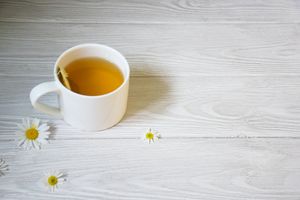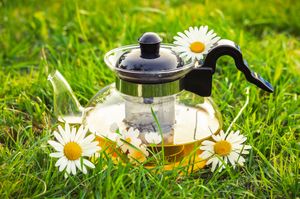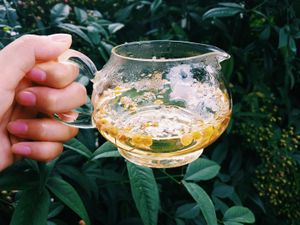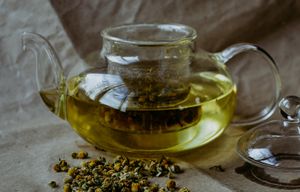Our pick of the best chamomile teas 2022
By Andrew Warner

Chamomile tea is, by and large, one of the most common home remedies for insomnia. The benefits of drinking chamomile tea, however, go a lot further than just that.
Unlike other types of tea, such as green tea or oolong, which are both derived from the Camellia sinensis plant, chamomile tea is an herbal tea. Herbal teas consist of infusing hot water with various flowers, herbs or even fruits. Herbal teas like the ones made from chamomile flowers or hibiscus buds have long been a part of the human diet.
Experts estimate that the chamomile flower’s status as a home remedy for various ailments dates back to at least 5,000 years ago. It’s probably got a much older history than that, though. It’s one of the oldest and most widely used herbal remedies known to man. Throughout history, herbalists have used it to treat inflammation, skin disorders, anxiety and more.
Not to mention, it tastes incredible. With its floral undertones, a warm mug of milky chamomile tea is perfect for winding down before bed. Here’s our guide to finding the right chamomile tea for you.
Types of chamomile tea
The chamomile plant is a member of the Asteraceae family, which also includes daisies and sunflowers. Its relationship to daisies shouldn’t be surprising. If you’ve ever come across a wild chamomile flower you may not have even recognized it for what it was. To the untrained eye, chamomile flowers are virtually indistinguishable from the average daisy, with their white petals and bright yellow center.
These daisies-in-disguise grow all across Europe, Asia, and North Africa. Historically, it’s played a large role in the traditional medicines of ancient empires like Rome and Egypt. Thanks to its widespread nature, there are plenty of different subspecies of the chamomile plant, each one having its own unique and nuanced flavor.
The main varieties you’ll come across when shopping around for chamomile are Roman, German, and Egyptian chamomile. While all three have that characteristic malty and sweet flavor profile, each one has a slightly different taste and health effects that you should keep in mind when selecting the right chamomile tea for you.
Roman
Ironically, Roman chamomile is not the same variant the ancient Romans swore by for treating various ailments. More on that chamomile variety in the next section.
In fact, Roman chamomile was not discovered until long after the fall of the Roman Empire. This chamomile became a popular herbal medicine throughout Europe during the Middle Ages.
Roman chamomile has a slightly sweeter, almost bubblegum-like flavor and scent. While it makes a great tea, Roman chamomile is particularly well-known for its topical applications in skin and hair care products.
German
German chamomile is native to southern and eastern Europe. It’s also known as “true” chamomile, and it’s the most common variant you’ll come across. With a slight apple-like scent, German chamomile is a fairly neutral and comforting tea.
Throughout its history, German chamomile has been a common home remedy for gastrointestinal problems. The flowers of German chamomile are particularly well-suited to helping individuals get over a sore stomach—some individuals even use it to help manage flare ups of irritable bowel syndrome. It also has excellent anti-inflammatory properties and helps with muscle relaxation as well.
Egyptian
Way back in Ancient Egypt, chamomile played a huge role in traditional medicine. It was so important that Egyptians even used it to pay respects to the gods and embalm the dead.
Even today, chamomile is an important crop in Egypt, where it’s grown all along the Nile River Valley. Like German chamomile, this flower has relaxing properties that help ease anxieties. It has an earthier and more mild flavor than Roman and German chamomile varieties.

The health benefits of chamomile tea
Chances are you’ve found yourself tossing and turning in bed, unable to sleep, at least once or twice in your life. On these occasions, many people swear by the caffeine-free herbal tea to help ease anxieties and relax them into a deep sleep.
While chamomile tea may have slight sedative effects, it’s important to know that that’s not the only thing the chamomile flower is good for.
In fact, it’s not even what chamomile is best for.
Chamomile tea has several different health benefits, and it plays a large role in the herbal medicinal traditions of many different cultures. Chamomile flowers are packed with all sorts of chemical compounds and antioxidants that can improve your health if you sip it in moderation.
Throughout human history, cultures have revered it for its ability to mitigate gastrointestinal ailments, such as indigestion, sore stomach, and stomach ulcers. Chamomile tea helps relax the muscles in the stomach, which allows food to pass more easily. Studies have also shown that chamomile helps prevent stomach ulcers from developing. It’s also been heralded for helping people get over the symptoms of the common cold.
Topical applications can also be beneficial. Chamomile infused lotions and conditioners can help provide moisture to dry skin or hair. For eczema, chamomile-infused ointments are nearly as effective as more commonplace treatments like hydrocortisone.
More recent research has shed light on several other health benefits of chamomile tea. Regular consumption of chamomile tea appears to improve one’s immune system. Some of the compounds present in chamomile, such as apigenin, have been shown to have cancer-fighting properties. Several studies have shown that exposure to chamomile has promising effects on reducing tumor size and fighting cancer cells. This research is still in its early days, however.
Tips for Choosing the Best Chamomile Tea
If you just want to enjoy the rich and sweet flavors of chamomile tea, you can’t really go wrong with any variety. Likewise, if you want a good night’s sleep, any of the above varieties of chamomile will get the job done.
However, there are a few things to keep in mind if you’re looking for specific health benefits. German chamomile is best for remedying stomach problems. On the other hand, Roman chamomile is better if you’re looking to produce homemade topical treatments.
German chamomile tends to be the variety that most people are familiar with. If you’d like to branch out and try new flavors, Roman or Egyptian chamomile may be the best option. Egyptian varieties are a bit earthier, which allows them to pair well with milk and honey for a nice nighttime substitute for your favorite black or green tea. Roman chamomile is already fairly sweet on its own, thanks to its characteristically sweet and fruity scent.
One important thing to keep in mind when selecting chamomile teas: Roman chamomile in particular may be harmful to pregnant women. Roman chamomile has chemical compounds that can induce a miscarriage, meaning that pregnant individuals ought to avoid this variety altogether.

Best chamomile teas
If you’re in the market for some new chamomile teas, we’ve got you covered. Whether you like your tea loose leaf or in teabags, we’ve rounded up the best chamomile teas for you to give a try. The following list of teas includes the best chamomile varieties that you can get right now.
We recommend trying a selection of several different brands, to get a better feel for which flavors you like best. Since the flavors and health benefits vary according to the terroir of the growing region, you may find slight differences in each of these teas. Rest assured, they’re all excellent options for chamomile lovers and newbies alike.
Best loose leaf
Starwest Botanicals offers an excellent Egyptian chamomile tea for those looking to try a slightly different flavor from the more well-known German varieties. This tea also happens to be loose leaf, making it an excellent option for those who prefer the fresher, more flavorful properties of a loose leaf (or in the case of chamomile, loose flower) tea.
Unlike German and Roman chamomile, Egyptian chamomile tends to be on the bitter side. We recommend brewing this tea with a splash of cream and a hint of honey, to counteract the more bitter notes.
Best organic
If you’re looking for something organic and sustainable, you can’t go wrong with Davidson’s Organics.
Davidson’s Organics grows their chamomile in India. It has a slightly different flavor profile from the other Roman, German and Egyptian varieties. Still, it’s an excellent addition to your tea repertoire. Chamomile lovers note in their customer reviews that the flavor is particularly concentrated compared to other chamomile teas.
Best with honey
If you like to add a touch of honey to your tea, this Egyptian chamomile from Art of Tea is an excellent option. As mentioned before, Egyptian chamomile tends to pair quite well with a touch of sweetness. Adding honey helps counterbalance some of the bitter notes present in Egyptian chamomile. Art of Tea’s Egyptian chamomile stands up quite well to a splash of cream as well, making it a comforting nighttime de-stresser.
Best teabags
When it comes to bagged tea, Harney & Sons is one of the finest options out there. Harney & Sons utilizes sustainably made tea sachets—these aren’t your average teabags. Instead of packing stale, ground-down leaves and stems in an old, paper teabag, Harney & Sons’ tea sachets contain whole leaves. This combines the convenience of a teabag with the high quality flavors of loose leaf tea.
Unlike some cheaper chamomiles, Harney & Sons’ chamomile tea only contains flower heads. Lower quality brands may contain stems or buds as well, but Harney & Sons utilizes a quality assurance process that ensures the highest quality flowers make it into your cup.
Best tea pods
Since chamomile tea can take a while to steep, tea pods for a Keurig or similar machine may be another good option. If you’re in a hurry, you likely don’t have time to wait seven minutes (or more!) for your chamomile to finish steeping. We recommend Twinings of London’s chamomile K-cups for chamomile lovers on the go. Customers note that this is one of the best chamomile K-cups on the market right now, thanks to its mild and nuanced flavor profile.
Best chamomile blend
If you need something that will surely leave you sleeping like a baby, this chamomile lavender blend will surely get the job done. Traditional Medicinals’ chamomile-lavender tea is the perfect nightcap to ease you into a deep sleep.
Lavender has slightly stronger sedative properties than chamomile. When you blend the two together, you’ve got a really powerful sleep potion. This is a great option for winding down after a stressful day at work.

Frequently asked questions
Can you drink chamomile every day?
Yes! It’s safe to drink chamomile tea every day—in fact, it’s more than safe. Some studies have shown that drinking one or two cups of chamomile tea per day can have the following health benefits:
- Better skin
- Better sleep
- Lower risk of cancer
- Lower blood pressure
- Decreased anxiety symptoms
Of course, you’ll want to keep things in moderation—drinking more than five cups of chamomile in a day is probably not the best idea. Although chamomile can alleviate gastrointestinal issues, it can also exacerbate them in extremely high doses. Additionally, if you have strong pollen allergies, you may want to avoid drinking too much, as chamomile teas may contain traces of pollen from cross-pollination.
Lastly, experts recommend that pregnant individuals avoid chamomile tea entirely. This is because Roman chamomile may induce a miscarriage—while other varieties may be safe, it can be difficult to verify the origins of your chamomile tea. Thus, it’s safest to avoid it altogether.
What’s chamomile tea good for?
Chamomile tea has several different benefits. Most people enjoy it for its slight sedative effects, but it’s got many other beneficial properties.
Sipping on chamomile tea has been shown to help improve your immune system, fight cancer, decrease anxiety symptoms, and ease cold symptoms. It’s also got muscle relaxing properties, which can help alleviate digestive issues and help you wind down after a stressful event.
Essential oils from the chamomile flower are also an excellent addition to your aromatherapy round-up as well. Topical applications can also be useful—you can find chamomile in numerous hair care products as well as skin care.
Plus, it’s got a refined and subtle flavor profile that’s sure to lift your mood. With all its health benefits and exquisite flavor, it’s a perfect guilt-free treat!
What’s the best time to drink chamomile tea?
If you’re trying to get a good night’s sleep with your cup of chamomile, you’ll want to brew it a little bit before bedtime. It’s best to drink chamomile tea about half an hour before you plan to go to bed, to maximize the tea’s sleep-inducing effects. While it’s obviously tasty no matter what time of day, drinking it just before bed ensures that its effects kick in right around when you want to be sound asleep.